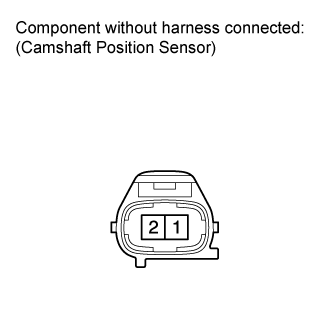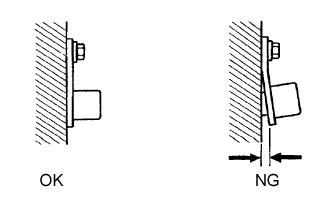Dtc P0340 Camshaft Position Sensor A Circuit (Bank 1 Or Single Sensor)
DESCRIPTION
WIRING DIAGRAM
INSPECTION PROCEDURE
INSPECT CAMSHAFT POSITION SENSOR
CHECK HARNESS AND CONNECTOR (CAMSHAFT POSITION SENSOR - ECM)
CHECK CAMSHAFT POSITION SENSOR (SENSOR INSTALLATION)
CHECK NO. 2 CAMSHAFT TIMING SPROCKET
REPLACE ECM
REPLACE CAMSHAFT POSITION SENSOR
REPAIR OR REPLACE HARNESS OR CONNECTOR
SECURELY REINSTALL SENSOR
REPLACE NO. 2 CAMSHAFT TIMING SPROCKET
CONFIRM WHETHER MALFUNCTION HAS BEEN SUCCESSFULLY REPAIRED
DTC P0340 Camshaft Position Sensor "A" Circuit (Bank 1 or Single Sensor) |
DESCRIPTION
The camshaft position sensor (G signal) consists of a magnet, iron core and pickup coil.The G signal plate (timing sprocket) has one tooth on its outer circumference and is installed on the camshaft timing chain gear. When the timing gear rotates, the protrusion on the signal plate and the air gap on the pickup coil change, causing fluctuations in the magnetic field that generate a voltage in the pickup coil.The NE signal plate has 34 teeth and is mounted on the crank angle sensor plate. The NE signal sensor generates 34 signals for every revolution. The ECM detects the standard crankshaft angle based on the G signal, and detects the actual crankshaft angle and engine speed based on the NE signal.P0340DTC Detection Drive Pattern
| DTC Detection Condition
| Trouble Area
|
Crank engine for 4 seconds (STA on)
| STA on:
No camshaft position sensor signal is sent to the ECM while cranking for 4 seconds or more (2 trip detection logic).
| - Open or short in camshaft position sensor circuit
- Camshaft position sensor
- No. 2 camshaft timing sprocket
- ECM
|
Idle engine for 1 second (STA off)
| STA off:
When either condition below is met for 1 second (1 trip detection logic):
- G signal is not input with an engine speed of 500 rpm or more.
- No camshaft position sensor signal is sent to the ECM with an engine speed of 500 to 3000 rpm 20 times or more.
|
- HINT:
- If DTC P0340 is stored, the following symptoms may appear:
- - Difficult starting
- - Misfire
- - Combustion noise
- - Black smoke
- - White smoke
- - Lack of power
WIRING DIAGRAM
Refer to DTC P0335 (Click here).
INSPECTION PROCEDURE
- NOTICE:
- After replacing the ECM, the new ECM needs registration (Click here) and initialization (Click here).
- HINT:
- Read freeze frame data using the intelligent tester. Freeze frame data records the engine condition when malfunctions are detected. When troubleshooting, freeze frame data can help determine if the vehicle was moving or stationary, if the engine was warmed up or not, and other data from the time the malfunction occurred.
| 1.INSPECT CAMSHAFT POSITION SENSOR |
Disconnect the camshaft position sensor connector.
Measure the resistance according to the value(s) in the table below.
- Standard Resistance:
Tester Connection
| Condition
| Specified Condition
|
1 - 2
| Cold
| 835 to 1400 Ω
|
1 - 2
| Hot
| 1060 to 1645 Ω
|
- HINT:
- In the table above, the terms "Cold" and "Hot" refer to the temperature of the coils in the sensor. "Cold" means approximately -10 to 50°C (14 to 122°F). "Hot" means approximately 50 to 100°C (122 to 212°F).
| 2.CHECK HARNESS AND CONNECTOR (CAMSHAFT POSITION SENSOR - ECM) |
Disconnect the camshaft position sensor connector.
Disconnect the ECM connector.
Measure the resistance according to the value(s) in the table below.
- Standard Resistance (Check for Open):
for LHDTester Connection
| Condition
| Specified Condition
|
C66-1 - C45-80 (G+)
| Always
| Below 1 Ω
|
C66-2 - C45-79 (G-)
| Always
| Below 1 Ω
|
for RHDTester Connection
| Condition
| Specified Condition
|
C66-1 - C46-80 (G+)
| Always
| Below 1 Ω
|
C66-2 - C46-79 (G-)
| Always
| Below 1 Ω
|
- Standard Resistance (Check for Short):
for LHDTester Connection
| Condition
| Specified Condition
|
C66-1 or C45-80 (G+) - Body ground
| Always
| 10 kΩ or higher
|
C66-2 or C45-79 (G-) - Body ground
| Always
| 10 kΩ or higher
|
for RHDTester Connection
| Condition
| Specified Condition
|
C66-1 or C46-80 (G+) - Body ground
| Always
| 10 kΩ or higher
|
C66-2 or C46-79 (G-) - Body ground
| Always
| 10 kΩ or higher
|
| 3.CHECK CAMSHAFT POSITION SENSOR (SENSOR INSTALLATION) |
Check the sensor installation.
- OK:
- Sensor is installed correctly.
| 4.CHECK NO. 2 CAMSHAFT TIMING SPROCKET |
Check the condition of the timing sprocket.
- OK:
- Timing sprocket does not have any cracks or deformation.
Replace the ECM (Click here).
| 6.REPLACE CAMSHAFT POSITION SENSOR |
Replace the camshaft position sensor (Click here).
| 7.REPAIR OR REPLACE HARNESS OR CONNECTOR |
| 8.SECURELY REINSTALL SENSOR |
Securely reinstall the sensor (Click here).
| 9.REPLACE NO. 2 CAMSHAFT TIMING SPROCKET |
Replace the No. 2 camshaft timing sprocket (Click here).
| 10.CONFIRM WHETHER MALFUNCTION HAS BEEN SUCCESSFULLY REPAIRED |
Connect the intelligent tester to the DLC3.
Clear the DTCs (Click here).
Turn the ignition switch off.
Start the engine and idle it for 2 seconds.
Enter the following menus: Powertrain / Engine / DTC.
Confirm that the DTC is not output again.


